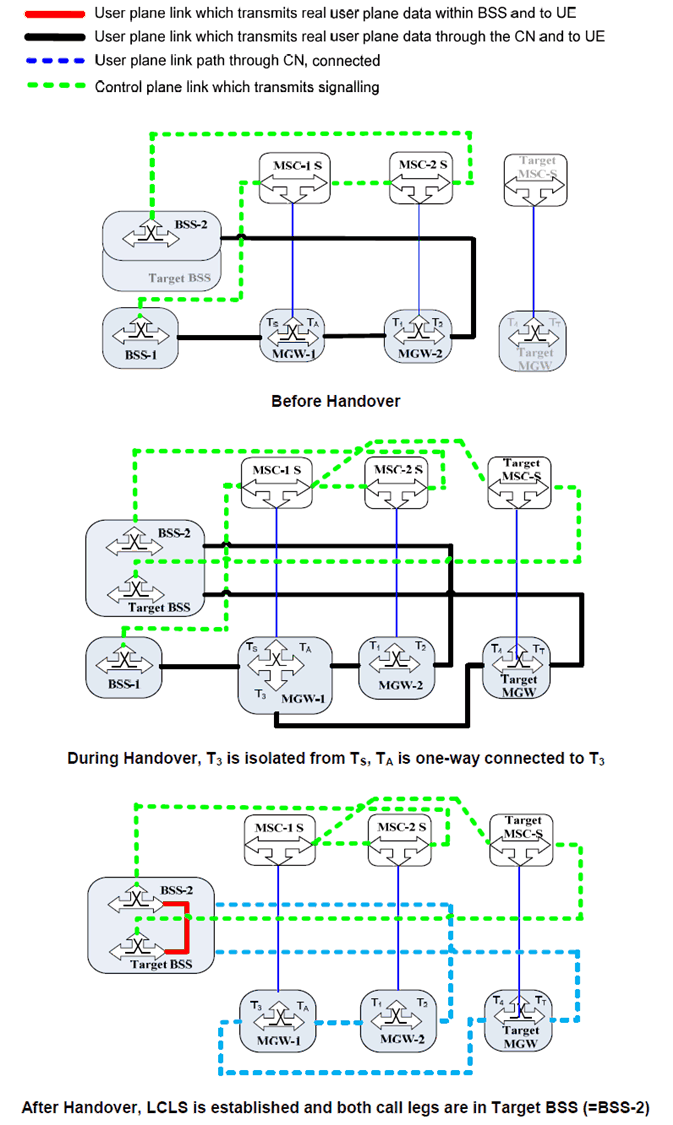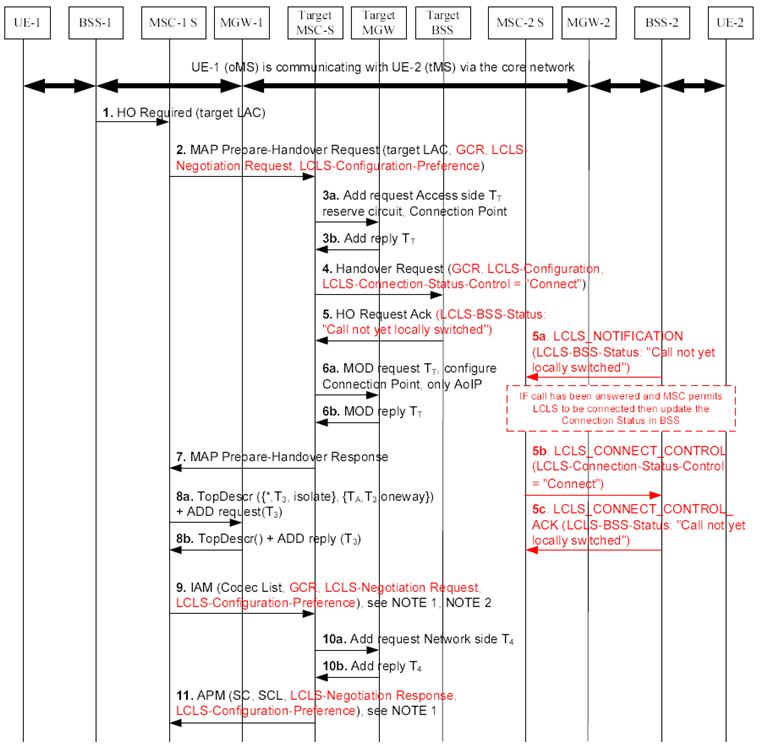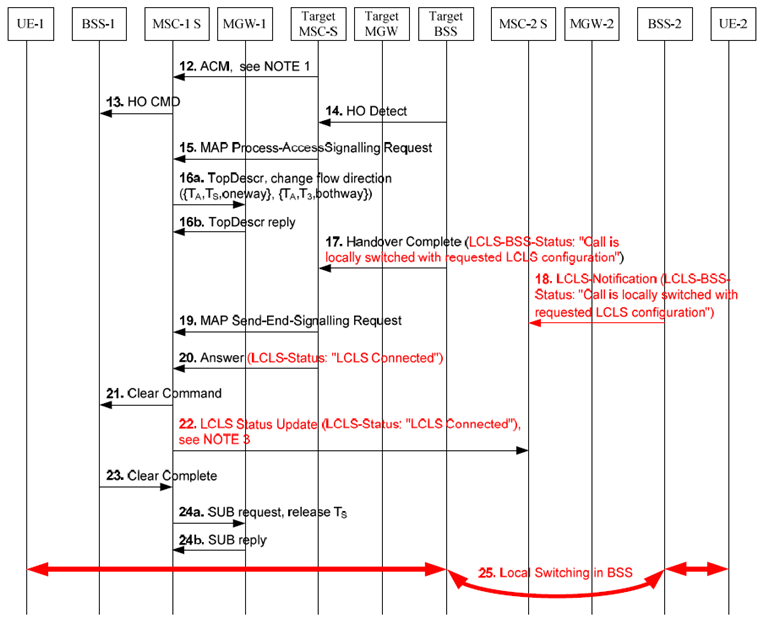Content for TS 23.284 Word version: 18.0.0
1…
4…
4.2…
4.3…
5
6…
6.3…
6.3.2
6.3.3
6.3.4
6.3.5
7…
7.2.4…
7.2.4.2
7.2.4.3
7.2.4.4
7.2.4.5
7.2.4.6
7.3…
7.3.4…
7.3.4.2
7.3.4.3
7.3.4.4
8…
8.2.3
8.3…
8.3.2
8.4…
8.4.1.1.7…
8.4.1.2…
8.4.2…
8.4.2.2…
8.4.5…
8.4.5.6
8.4.5.7
8.4.5.8…
9…
13…
13.4…
13.4.3…
13.4.4…
13.5…
13.6…
13.7…
14…
16…
A…
A.2…
8.4.2.2 Inter-MSC GSM to GSM Handover that establishes Local Switching
8.4.2.3 Inter-MSC Handover that leaves a not Locally Switched Call unchanged
8.4.3 Subsequent Inter-MSC GSM to GSM Handover back to the Anchor MSC
8.4.4 Subsequent GSM to GSM Handover to a third MSC
...
...
8.4.2.2 Inter-MSC GSM to GSM Handover that establishes Local Switching p. 111
8.4.2.2.1 General p. 111
When LCLS is not established for a call and an inter-MSC handover occurs that makes the call local, the call should be locally switched in the BSS. The Inter-MSC handover procedures specified in TS 23.009, TS 23.205 and TS 23.231 shall be followed. The following clauses describe the additional requirements for inter-MSC handovers that establish LCLS and the differences compared to Inter-MSC handovers that break LCLS are identified.
8.4.2.2.2 MSC-1 / MGW-1 p. 111
8.4.2.2.2.1 Handover Required p. 111
When MSC-1 Server receives the Handover Required message from the serving BSS and determines that the call shall be handed over to the Target MSC Server, it shall send the GCR of the call, the LCLS-Negotiation Request IE and the LCLS-Configuration-Preference IE to the Target MSC Server in a MAP Prepare-Handover_Request message.
8.4.2.2.2.2 Handover Request Acknowledge p. 112
When MSC-1 Server receives the MAP Prepare_Handover_Response including Handover_Request_Acknowledgement message with a LCLS-BSS-Status IE the Anchor MSC-1 Server configures the bearer terminations in MGW-1 and sends the GCR IE, the LCLS-Negotiation Request IE and the LCLS-Configuration-Preference IE to the target MSC-Server.
8.4.2.2.2.3 Bearer establishment between MGW-1 and Target MGW p. 112
The handling of the bearer establishment between MGW-1 and Target MGW is as described in clause 6.1 for a Basic Mobile Originating Call. The MSC server shall also use the Change Flow Direction procedure to request the MGW-1 to set the Handover Device to the initial state.
8.4.2.2.2.4 MGW Flow Direction Control p. 112
In accordance with the normal handover case the MGW-1 isolates the termination towards the Target MGW (T2) from the termination to the Serving BSS (TS) and configures the Anchor termination (T1) one-way DL towards the Target MGW termination (T2). Termination to the Serving BSS (TS) is both-way connected to Anchor termination (T1) since it is also receiving UL user data from termination to the Serving BSS (TS).
8.4.2.2.2.5 Handover Command/Handover Detect p. 112
The MSC-1 Server shall use the Change Flow Direction procedure to requests the MGW-1 to set the Handover Device to intermediate state.
8.4.2.2.2.6 Handover Complete p. 112
When the MSC-1 Server receives the Handover Complete message, it releases the A-interface line towards BSS-1. The MSC-1 Server also requests MGW-1 to set the Handover Device to its final state by removing the bearer termination towards the BSS-1.
When LCLS has been established during the handover procedure, the target BSS informs the target MSC-Server that the call has been locally switched in the Handover Complete message,
8.4.2.2.3 Target MSC Server / Target MGW p. 112
8.4.2.2.3.1 Prepare Handover Request message and MGW selection p. 112
The Target MSC server selects the Target MGW when it receives Prepare Handover Request message. The Target MSC server sends the Handover Request message to the Target BSS as for the normal case but shall include the GCR IE, the LCLS-Configuration IE and the LCLS-Connection-Status-Control IE set to "Connect".
8.4.2.2.3.2 Handover Request Acknowledge p. 112
If the Target BSS supports the LCLS feature it shall include the LCLS-BSS-Status IE in the Handover Request Acknowledge message in order to inform the Target MSC Server that the BSS supports the LCLS feature. The Target MSC Server sends the same information in the MAP Prepare Handover Response message to the MSC-1 Server.
8.4.2.2.3.3 Bearer establishment towards Target BSS p. 112
When the Target MSC Server has selected the Target MGW it requests the Target MGW to seize a TDM circuit if AoTDM using the Reserve Circuit procedure, or an IP termination if AoIP using the reserve Connection Point procedure as for the normal handover procedure. The Target MSC Server sends the Handover Request message to the Target BSS containing the CIC for AoTDM or the IP addresses and UDP ports received from the target MGW if AoIP.
8.4.2.2.3.4 Bearer establishment between MGW-1 and Target MGW p. 112
The handling of the bearer establishment between MGW-1 and Target MGW is as described for basic mobile terminating call in clause 6.2.
8.4.2.2.3.5 LCLS Negotiation in Initial Address message p. 113
If the Target MSC Server receives an Initial Address message that does not include a LCLS-Negotiation Request IE or includes a LCLS-Negotiation Request IE set to LCLS is not permitted, the Target MSC Server shall update the previously sent LCLS-Configuration by sending a LCLS_CONNECT_CONTROL message to BSS with a LCLS-Configuration IE set to LCLS-not allowed and a LCLS_Connection_Status_Control IE set to "do not connect LCLS". The inter-MSC handover continues as described in clause 8.4.2.3 Inter-MSC Handover that leaves a not locally Switched Call unchanged.
8.4.2.2.4 Example of Inter-MSC Handover that establishes Local Switching p. 113
8.4.2.2.4.1 Connection Model p. 113
Figure 8.4.2.2.4.1.1 shows the network model for the Basic Inter-MSC GSM to GSM handover when LCLS is established as a result of the handover. The dashed line in green represents call control signalling and the dashed line in blue represents the user plane connection path via the core network, which should be used if LCLS is not established or after LCLS is broken. The non-dotted lines represent the bearer carrying real user plane data. In MGW-1 the bearer termination TS is used for the bearer towards BSS-1, bearer termination TA is used for the bearer towards the succeeding/preceding MGW, that is MGW-2 and bearer termination T3 is used towards the Target MGW. In MGW-2 the bearer termination T2 is used for the bearer towards BSS-2 and bearer termination T1 is used for the bearer towards MGW-1. In Target-MGW the bearer termination TT is used towards the Target-BSS and bearer termination T4 is used towards MGW-1.
In this example scenario the Handover Device is located in MGW-1 selected for the call establishment by the MSC-1 server, which controls the call and mobility management.

Figure 8.4.2.2.4.1.1: Basic Inter-MSC GSM to GSM Handover (network model)
(⇒ copy of original 3GPP image)
(⇒ copy of original 3GPP image)
8.4.2.2.4.2 Basic Sequence for Inter-MSC GSM to GSM Handover that establishes Local Switching p. 115
Figure 8.4.2.2.4.2.1 and Figure 8.4.2.2.4.2.2 show the message sequence example for the Basic Inter-MSC GSM to GSM Handover shown in the corresponding network model Figure 8.4.2.2.4.1.1. The Handover Device is located in MGW-1 selected for the call establishment by the MSC-1 server, which controls the call and the mobility management. The description is based on TS 23.009, TS 23.205 and TS 23.231.

Figure 8.4.2.2.4.2.1: Initial phase of Inter-MSC Handover establishing Local Switching
(⇒ copy of original 3GPP image)
(⇒ copy of original 3GPP image)
Step 1.
Handover Required message is received from BSS-1 requesting an inter-MSC handover. The call is currently not locally switched.
Step 2.
The MSC-1 server determines that inter-MSC handover is required and sends the Pre-Handover Request message to target MSC-Server which includes LCLS Negotiation Request, the LCLS-Configuration-Preference and GCR IEs and GCR.
Step 3a, b.
Target-MSC-Server reserves circuit or Connection Point towards the Target-BSS
Step 4.
Target MSC-Server sends Handover request message to target BSS with GCR and instructs the BSS to prepare to connect LCLS. The LCLS-Configuration IE can instruct the BSS to bi-cast user plane data, if applicable.
Step 5.
Target BSS performs call leg correlation with GCR to find if another call leg is active with same GCR. The BSS reports in Handover Request Acknowledge message that the local call was found but LCLS is not yet established.
Step 5a.
The BSS-2 notifies MSC-2 server the LCLS status is changed by sending the LCLS_Notification message with the LCLS-BSS-Status IE set to "Call not yet locally switched".
Step 5b.
If the call has been answered and MSC-2 server permits LCLS to be connected, then the MSC-2 server sends to the BSS-2 the LCLS_Connect_Control message with the LCLS-Connection-Status-Control IE set to "connect".
Step 5c.
The BSS-2 returns the LCLS_Connect_Control_ACK message with the LCLS-BSS-Status IE set to "Call not yet locally switched".
Step 6a, b.
(These signalling steps are only applicable to AoIP.) When the Target MSC-Server receives the BSSMAP Handover Request-Ack message, it sends the BSC-B IP address and UDP Port number to the MGW-B using the Configure RTP Connection Point procedure.
Step 7.
The Target MSC-Server sends the Prepare Handover Response message to MSC-1 server.
Step 8, b.
In accordance with normal handover the MSC-1 server requests MGW-1 to isolate the termination towards Target MGW (T3) from the termination to the Serving BSS-1 (TS) and to configure the Anchor termination (TA) one-way DL towards the Target MGW termination (T3).
Step 9.
MSC-Server 1 sends IAM (Initial Address Message) to Target MSC-Server including GCR, the LCLS-Negotiation Request IE and the LCLS-Configuration-Preference IE.
Step 10a, b.
Target MSC-Server reserves bearer connection T4 towards MGW-1.
Step 11.
After Target MGW has replied with the bearer address and the binding reference (Step 10b), the Target MSC-Server returns the Bearer and Codec Information (APM) message with selected codec, available codec list and the LCLS-Negotiation Response IE and the LCLS-Configuration-Preference IE.

Figure 8.4.2.2.4.2.2: Completion phase of Inter-MSC Handover establishing Local Switching
(⇒ copy of original 3GPP image)
(⇒ copy of original 3GPP image)
Step 12.
Target MSC-Server sends ACM (Address Complete Message). Target MSC-Server awaits the capturing of the UE-1 on the radio path when the ACM is sent and MSC-1 server initiates the handover execution when receiving ACM.
Step 13 - 18.
When the local switching has been established during the handover procedure, the target BSS shall inform the target MSC-Server that the call has been locally switched in Handover Complete message, and the target BSS shall also send a new message LCLS-Notification with LCLS-BSS-Status IE to inform the MSC-2 server that the local switching has been established. In steps 16a and 16b the MSC-1 server configures MGW-1 for the completion of the handover.
Step 19.
A Handover-Detect/Complete when received is included in the MAP-Send-End-Signalling request and sent back to the MSC-1 server.
Step 20.
Target MSC-Server sends ANSWER message with the LCLS-status when A-HO-DETECT/COMPLETE is received.
Step 21.
MSC-Server 1 clears the call in BSS-1.
Step 22.
MSC-1 server (Anchor MSC-Server) sends LCLS-Status-Update message to the far end MSC-2 server.
Step 23.
BSS-1 informs MSC-1 server that the resource for the UE-1 has been released
Step 24a, b.
MSC-1 server releases the bearer termination towards BSS-1.
Step 25.
Local switching is established in the BSS.
8.4.2.3 Inter-MSC Handover that leaves a not Locally Switched Call unchanged p. 118
In this scenario it is assumed that LCLS was not established before the Inter-MSC handover. When one call leg is handed over to another MSC-Server, the call still remains not local. LCLS cannot be established for the call and the LCLS status of the call is not changed.
For the Anchor MSC-1 server and Target MSC server this Inter-MSC handover is similar to the Inter-MSC handover that establishes LCLS as described in clause 8.4.2.2.4.2 until Step 5, but in this case in Step 5 the Target BSS sends the Handover Request ACK message, where the LCLS-BSS-Status IE indicates that the call is not possible to be locally switched since the GCR correlation will indicate that the call is not local. Steps 5a, 5b, 5c will not be triggered. The handover procedure is completed as for a non-local call, LCLS is not established and the LCLS Status in the core network is not changed.
8.4.3 Subsequent Inter-MSC GSM to GSM Handover back to the Anchor MSC p. 118
The basic Inter-MSC GSM to GSM handover procedure as specified in this specification shall be applied.
8.4.4 Subsequent GSM to GSM Handover to a third MSC p. 118
The basic GSM to GSM handover procedure as specified in this specification shall be applied.